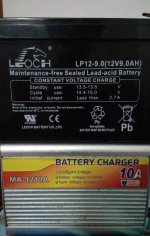pmmali said:
now every one is saying divide the battery amperage by the charger amperage to get the charging time. but in real tis timing is totally different. i don't know where is mistake on battery or charger.
The actual charging rate is a curve, not linear, and depends on the state of charge SoC of the battery when you start charging, so the math is not completely straightforwardly simple. However, the simple math is an estimate that can come pretty close.
When it doesn't match reality at all, it means something is happening during charge that is not as expected, or the conditions at start or end of charge are not as expected, and you would have to measure start voltage (to guesstimate how much charge it started with), end voltage, charge current during charge, and preferably even Ah going into the battery and out of it.
for example. i have 12V 9.0AH battery (its written on it) and 12V 10A charger
If this charger is not adjustable current limit (like with an easy-to-access knob or switch on it's casing), I'd recommend strongly to use a much lower current charger for a battery that size. The charge rate listed on the battery in your picture is less than 2.7A; charging at a rate higher than that can damage the battery over time. If it's at or near the 10A rate for very long, it may really heat up the battery and boil the electrolyte away, which will damage the battery and reduce it's performance at best, or kill it so it won't hold a charge, or even swell the casing and rupture it.
when i charge this battery from this charger it take around 3 hours to charge.
The *average* charge rate for 9Ah of capacity over 3 hours is 9Ah / 3h = 3A.
(But the average is not the important number for meeting the battery's needs. )
If the battery is completely empty (at whatever the manufacturer specifies as empty voltage, but typically around 10v), then a 9Ah battery taking 3 hours to charge on a 10A charger is probably taking the full 10A at first (almost four times what the battery is designed to be charged at), rapidly dropping to a few amps, then near the end to much less, finally just trickling in.
If the battery is not completely empty, then it's not putting 9Ah in, so the average rate would be lower. Say it's half empty, 4.5Ah, so 4.5Ah / 3h = 1.5A.
But the actual charge rate is going to be different than those, and to know it with certainty you'd need to measure it with a wattmeter or ammeter (or multimeter on DC Amps, if it is designed to handle at least 10A or more).
So calculation is not matching, now how can i confirm or how to measure, how much ampere this charger really giving to battery. on the same time how can i confirm or how to know what is a exact amperage on the battery
because all these Chinese batteries and chargers are written wrong or manipulated values for selling purpose.
If you don't trust the seller specs (I often don't, but I'm sure some are honest) then you can't know what a battery actually is designed to be capable of charging at without going to the manufacturer's website and reading their specifications for the specific model battery you have. If there is no spec available, you can guesstimate what it might be, with lead batteries, by dividing the Ah marked on the battery by four (or more), and charging at a current lower than that.
Some of them may be capable of higher currents, but if you're not sure, you're safer to use lower.
To find out what current and voltage a charger is actually charging at (or how much load a bike, scooter, etc is putting on a battery when using it) you can use a wattmeter. There are many kinds, and which one to use depends on your specific usage needs. You can probably get one for less than $20-40. Some of them can do a lot of things, some only a few, all you really need is one that measures voltage (V), current (A), and amphours (Ah). If it will do Watts (W) and Watt hours (Wh) it's a bonus, and if it will save the data if power is lost even better. ISome use a shunt built into them, and some use an external one for higher currents, the latter is a bit more complicated to wire (the other just goes directly between the battery and charger or battery and controller, + to + and - to -). It must be able to handle the maximum possible current you'll ever put thru it, and the maximum possible voltage you'll ever need to charge the battery to.


![6184ZIBlTBL._AC_SL1500_[1].jpg 6184ZIBlTBL._AC_SL1500_[1].jpg](https://endless-sphere.com/sphere/data/attachments/186/186790-a876a228ae797887e055854732ec5d66.jpg)
![b43d4a14-aacd-45f2-8e20-93d1c28d1d19_1.14d86c63dd59248fcce9966578d23942[1].jpeg b43d4a14-aacd-45f2-8e20-93d1c28d1d19_1.14d86c63dd59248fcce9966578d23942[1].jpeg](https://endless-sphere.com/sphere/data/attachments/186/186791-f32a269747e4d8d0b369eeb73bef78d4.jpg)
